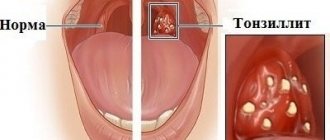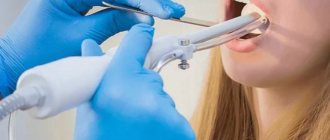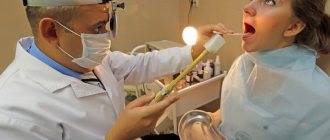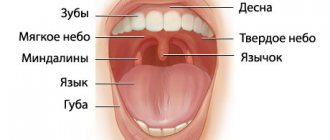Enlarged tonsils in a child are not a disease, but a symptom that signals pathological changes occurring in the young body. As practice shows, parents go to the doctor only if the baby’s body temperature increases, since it is believed that temperature is the only significant signal indicating that the child is sick. And this is a big mistake. The condition when one tonsil is larger than the other, or both are enlarged at once, can occur without fever or sore throat. And it also requires increased attention from parents.
Why do tonsils get enlarged? Tonsils are special organs of the immune system in the human nasopharynx. They consist of lymphoid tissue, protect the body from pathogens and prevent their further spread. The leading role in the body belongs to the palatine tonsils, or tonsils. The tonsils are located on the sides of the pharynx and meet infection that has entered through inhaled air or food. As soon as viruses and bacteria come into contact with the surface of the tonsils, the child's tonsils enlarge. At this time, there is an increased production of leukocytes - cells that attack and destroy the infection. When an enemy is defeated, the tonsils return to their original size. In other words, the large size of the palatine tonsils indicates that they are fighting pathogenic microflora.
But even when the tonsils are in a healthy state, it is important not to lose vigilance: normally, every person has bacteria on their mucous membranes that do not manifest themselves in any way, but under the influence of favorable conditions, they begin to multiply, provoking hypertrophy of the tonsils. These reasons for enlarged tonsils in children include:
- hypothermia;
- allergic reactions;
- deviated nasal septum;
- chronic diseases of the ENT organs;
- too dry air;
- living in a place with an unfavorable environment.
Anatomy of the throat
In the pharynx, on the sides and along the back wall, as well as on the border of the oral and nasal cavities, there are accumulations of lymphoid tissue - the so-called lymphoid-pharyngeal ring. It performs a protective function, and each of the tonsils of this ring is an important organ of our immunity.
The largest accumulations of lymphoid tissue are called tonsils (they are also called tonsils ) and there are several of them: two palatine, two tubal, one pharyngeal (aka adenoid) and one lingual.
Inflammation of the palatine tonsils (in everyday life they are called tonsils) is called acute tonsillitis or tonsillitis .
GBOU "NIKIO im. L.I. Sverzhevsky" of the Moscow Department of Health
Hypertrophy of the lingual tonsil
The lymphadenoid tissue of the root of the tongue is presented in the form of two clusters of large follicles located in rows or in random groups. These clusters are separated by a central groove extending from the middle of the lingual epiglottis fold to the largest, final, circumvallate papilla on the root of the tongue. Therefore, it is more correct to talk about not one, but two lingual tonsils. The number of large follicles in a 1-year-old child is 10-12, and in a 5-year-old child it is 20-30. At the age of 35 to 40 years, the maximum number of follicles (35-40) is observed with a simultaneous increase in their size. After 45 years, the number of follicles decreases and the size of each of them decreases (A.I. Tseshinsky, 1951).
One must think that the main cause of hypertrophy of the lingual tonsil in adulthood is inflammatory processes in the oropharynx. In some cases, hypertrophy of the lingual tonsil develops as a compensatory process in individuals who have had their palatine tonsils removed (B. S. Preobrazhensky).
Symptomatology and diagnosis of hypertrophy of the lingual tonsil.
Severe enlargement of the lingual tonsil can cause mechanical difficulty in breathing and voice production. Such cases, however, are very rare. Typically, patients with hypertrophy of the lingual tonsils complain of a feeling of pressure projected into the area of the hyoid bone, a sensation of a foreign body in the throat, cough, and sometimes laryngospasm . These complaints are not pathognomonic for hypertrophy of the lingual tonsil. Therefore, their assessment requires caution. Sometimes patients with hypertrophy of the lingual tonsils complain of coughing paroxysms. In such cases, mechanical irritation of the lingual tonsil using a probe can provide some assistance in diagnosis. If cough occurs only when the lingual tonsil is irritated, then it seems likely that it is the receptive field of the cough reflex.
When making a differential diagnosis, you need to keep in mind the following diseases.
- Inflammatory processes in the area of the root of the tongue. They can be caused by a banal infection (abscesses and phlegmon of the root of the tongue), tuberculosis, syphilis and various fungi (actinomycosis, coccidioidomycosis, blastomycosis, moniliasis). These diseases differ from hypertrophy of the lingual tonsil by the asymmetry of the lesions, their greater density and more saturated color. Histological (biopsy), serological and bacteriological examination helps.
- Tongue root cysts. In this area, there are retention cysts of the mucous glands and very rarely - cysts formed from elements of the thyroglossal duct. They are distinguished by a smooth-stressed surface.
- Benign tumors - adenomas and mixed tumors of the salivary glands are more common. They are also distinguished by their smooth surface and significant density.
- Malignant tumors - cancer and lymphoepithelial tumors are usually observed. Diagnosis is simple for ulcerated tumors.
- The goiter of the tongue root is distinguished by a pink, smooth surface covered with a network of highly developed venous vessels. It has a significantly higher density than hypertrophied lymphadenoid tissue. In some cases, the thyroid gland is absent in its usual place, which can be confirmed by palpation of the neck in thin individuals. Research with radioactive iodine helps, which, after ingestion, is concentrated in the thyroid tissue, as a result of which strong gamma radiation is detected in the area of the root of the tongue.
Treatment of hypertrophy of the lingual tonsil.
With moderate hypertrophy, patients are prohibited from smoking and eating spicy foods. Sometimes alkaline rinses and lubrication with iodine-glycerin are beneficial. Some authors recommend cauterization with lapis and galvanocauter. The use of radiation therapy has been proposed. With severe hypertrophy of the lingual tonsil, its surgical removal is indicated. It can be removed piece by piece by “biting” under the control of a laryngoscopic mirror. Some authors prefer to perform complete enucleation of the lingual tonsils along with the capsule. Such intervention is especially advisable in cases where there are significant inflammatory changes in the hypertrophied lingual tonsils or if these tonsils are the cause of repeated phlegmonous inflammation in the area of the root of the tongue, damage to the kidneys, joints and other organs. Before the operation, a detailed clinical examination of the patient is necessary, studying the blood picture, its coagulability, counting the number of platelets, etc.
We perform removal of the hypertrophied lingual tonsil using a holmium laser (Ho:YAG) with a radiation power of 4.8 W (energy - 0.6 J, frequency - 8.0 Hz).
Causes of tonsillitis
The most common pathogens should be highlighted:
| PATIENT | A COMMENT | ||
| pathogen: | Bacteria: beta-hemolytic streptococcus of group A and other groups, pneumococcus, Staphylococcus aureus, Neisseria, enterobacteria | a comment: | Particularly worth highlighting is streptococcal tonsillitis, in which infection occurs with group A beta-hemolytic streptococcus, which occurs in almost 30% of cases and is responsible for the further development of acute tonsillitis and exacerbation of chronic tonsillitis.3 |
| pathogen: | Viruses: adenoviruses, enterovirus, Epstein-Barr virus, influenza viruses, herpes virus | ||
| pathogen: | Mushrooms: yeast-like fungi of the genus Candida |
The infection is transmitted by airborne droplets through direct contact, penetrating the mucous membrane of the tonsils. But it can also be in the body without manifesting itself in any way. Periods of outbreaks of seasonal ARVI, hypothermia, the presence of chronic diseases of the pharynx, poor diet, bad habits, injuries - all these factors can lead to a decrease in immunity, which in turn provokes the growth of bacterial, less often fungal flora, and activates some viruses.
All these factors lead to inflammation of the tonsils and surrounding structures.
Depending on the pathogen, there are:
- Purulent tonsillitis (caused by bacteria)
- Viral tonsillitis
- Fungal tonsillitis
Forms of tonsillitis
There is a large classification of forms of acute tonsillitis :
Catarrhal
The mildest form, in which the mucous membrane of the tonsils is affected. The palatine tonsils are not very enlarged, the mucous membrane of the throat is red, there is no plaque or pus.
Follicular
In this form, the follicles of the tonsils, that is, the deeper structures of the tonsils, are affected. They are visible through the tissue of the tonsils in the form of whitish-yellow round formations.
Lacunarnaya
It leaks more severely. When examined, yellowish-white and purulent plaques can be seen on the tonsils.
Fibrinous
A dense film of grayish fibrin forms on the tonsil, which is difficult to remove with a spatula.
Herpetic
Characterized by the appearance of blisters on the tonsils. When they rupture, painful, difficult-to-heal ulcers form.
Phlegmonous
With this form, after 1-2 days of acute tonsillitis, an abscess (cavity with pus) develops.
Ulcerative-necrotic
Angina of Simanovsky-Plaut-Vincent.
As a rule, one tonsil is involved in the process, on which a grayish-yellowish coating forms with the development of ulcers underneath it.
Mixed forms
In this variant of the disease, infection occurs with several pathogens at once, as a result of the addition of a secondary infection or with a severe decrease in immunity.
Chronic form of tonsillitis
Relevant in the same way as acute.
Understanding the significance and prevalence of bacterial tonsillitis pathogens, especially group A beta-hemolytic streptococcus, has a huge role in preventing the development of chronic tonsillitis. Allergic syndrome is caused by the allergenic effect of streptococcal lipopolysaccharides, which, when absorbed throughout the disease, cause an allergic mood and create the preconditions for the development of local and general complications.
Tonsil hyperplasia in children
The child's body is often exposed to infections, such as whooping cough or scarlet fever. Hypertrophic processes are launched as compensatory ones. The diagnosis in question is made mainly to children under the age of ten years. Hyperplasia does not manifest itself as an inflammatory process. The tonsils are pale yellow in color, they are not red.
With the 1st degree of proliferation there are no symptoms. If growth is intense, then parents note a nasal voice of the child, breathing complications and other symptoms that were listed above. A large number of follicles, which are more fragile than normal, close the gaps without plugs.
Symptoms of acute tonsillitis
The onset of the disease is characterized by an acute and abrupt onset.
- Pain in the throat and when swallowing is the main symptom of a sore throat. The pain can be very intense, intensifies when swallowing, radiates into the ear, and this greatly reduces the patient’s quality of life
- The development of a sore throat is explained by irritation of a large number of nerve endings in the throat due to swelling and inflammation.4
- Depending on the form of acute tonsillitis, there is an increase in temperature from 37 to 39, and sometimes up to 40 degrees
- Against the background of increased temperature and intoxication, headache, weakness, weakness, and loss of appetite may occur.
- The submandibular and cervical nodes increase in size and may be painful when pressed
What tests need to be taken for tonsillitis?
In order to determine the pathogen and determine further treatment, the doctor may prescribe a number of laboratory tests to the patient, for example:
- a smear from the tonsils, arches and back of the throat to identify bacteria and their resistance to various groups of antibiotics, but such a study may take several days
- rapid test for the detection of group A beta-hemolytic streptococcus to determine streptococcal tonsillitis5
- a general blood test with a leukocyte formula, which pays attention to elements that reflect inflammation and the immune response to the disease. Increased band neutrophils, leukocytes, increased ESR, decreased lymphocytes
- CRP (C-reactive protein - a marker of inflammation) is the most sensitive protein responsible for inflammation in the body
How to treat acute tonsillitis
Treatment of acute tonsillitis or tonsillitis depends on the pathogen and the severity of the disease.
1. If we are talking about bacterial infection, then it is necessary to prescribe antibacterial drugs of different groups.
Only a doctor can prescribe an effective antibiotic!
Antibiotics are not effective against viral tonsillitis.
2. Symptomatic treatment:
Includes taking antipyretics, painkillers, as well as the use of local anti-inflammatory and antimicrobial drugs in the form of solutions, lozenges, tablets.
3. A gentle diet. Namely, the exclusion of spicy, fried, and sour foods will help reduce irritation to the inflamed tissues of the throat.
4. If treatment is ineffective or complications occur, hospitalization is indicated. In the hospital, the patient will be under the close attention of doctors, blood tests will be monitored, and hormonal and anti-inflammatory drugs may be administered. It is possible to use systemic antibiotics in the form of tablets or intravenously or intramuscularly.
If necessary, surgical intervention is performed.
Regardless of the severity of the disease, pathogen and form, treatment must be comprehensive, that is, have an antimicrobial, anti-inflammatory and analgesic effect. Uncontrolled treatment with folk remedies can only do harm.
Diagnosis of chronic tonsillitis
Diagnostic measures begin with an examination of the patient by a doctor who is interested in the appearance of the tonsils, as well as the presence of purulent or other contents in the lacunae. If this is detected, then it is necessary to conduct a bacteriological analysis of the discharge, followed by testing for sensitivity to antibiotics. A similar procedure is performed even if surgical removal of the tonsils is indicated to prevent postoperative infectious complications.
Often diagnostic measures include consultation with a cardiologist, nephrologist and so-called rheumatic tests. This allows you to determine how far the process has gone and whether there is systemic autoimmune damage to the target organs, such as the heart, kidneys and joints.
If there are indications for surgical removal of the tonsils, the patient must undergo additional examination, which includes:
- Blood test for hepatitis and HIV infection;
- Blood sugar test, since diabetes mellitus is a contraindication to such an operation;
- Cardiogram;
- Consultation with a therapist.
Acute tonsillitis in pregnant women
The pregnancy period is always accompanied by a physiological decrease in immunity due to complex hormonal changes, therefore, during the period of colds, the body's susceptibility to bacteria and viruses increases or activation of any chronic foci of infection, including chronic tonsillitis, is possible.
throat or acute tonsillitis are extremely undesirable diseases during pregnancy, since treatment of this group of patients can be difficult due to restrictions on the use of most medications, especially antibiotics. Therefore, the prevention of colds during the period of influenza and ARVI is of great importance: avoid crowded places, avoid contact with people with sore throat, thoroughly wash your hands, ventilate rooms, walk in the fresh air.
Pregnant women suffering from chronic tonsillitis without exacerbation are recommended for local treatment in the form of gargling with herbal solutions at home.12
The use of ANY medications, including dietary supplements, is permissible only after consulting your obstetrician-gynecologist!
Complications of tonsillitis
With proper treatment, recovery occurs in 7-10 days. If medications are ineffective, life-threatening complications may develop:
- paratonsillitis - acute inflammation of the tissues near the tonsils;
- peritonsillar abscess - the formation of a cavity with pus inside the same area;
When the process spreads into deeper tissues, phlegmon may develop. All types of complications are observed and treated exclusively in the hospital, with further use of surgical treatment methods .
Prevention of tonsillitis
There are individual preventive measures aimed primarily at strengthening the immune system.
A healthy lifestyle and the absence of bad habits such as smoking and drinking alcohol play a key role. Don’t forget about hardening the body, doing physical exercise, regularly spending time in the fresh air, and consuming enough vitamins with food.
In the modern world, special attention is paid to the use of various biologically active additives (BAS) to improve health, including for the prevention of colds and strengthening the immune system.
The composition of such supplements is very diverse and rich, including various vitamins, minerals, nutrients, and substances of plant origin.
They come in the form of tablets, lozenges, dragees, drops, etc. But you shouldn’t count on “magic”; such supplements will not cure all diseases, but they will really help direct the body to work in the right direction and improve the effect of the main treatment. It is also important to choose the right biological supplement, focusing on the body’s needs and its problem. For example, lozenges can help strengthen the immune system.
Tantum® Propolis 13
Propolis is a valuable substance that has been used for medicinal purposes since the times of Hippocrates, Discorides, Avicenna and others, and is used in modern medicine to this day.
Plants from which bees collect and carry resinous substances have bactericidal, anti-inflammatory, immunomodulating, and antiviral properties.14 Find out more
Not being a medicine, Tantum® Propolis can support the patient’s immunity during seasonal ARVI and influenza, reduce pain, irritation and itching in the throat, and also replenish the lack of vitamins in the patient’s body.
In preventing complications, it is very important to consult a doctor on time, follow the prescribed treatment regimen and recommendations, and avoid self-medication.
Prevention
It is important to live in favorable conditions, keeping the room clean, maintaining a normal level of air humidity and a temperature comfortable for the human body. Nutrition must be correct for the immune system to be active. In autumn and winter, you need to dress according to the weather, not breathe through your mouth, so that the tonsils are not exposed to icy air.
To maintain immunity, hardening, spa treatment, and additional courses of minerals and vitamins may be important. Respiratory and any other diseases must be treated on time so that they do not become chronic.
Answers to popular questions about tonsillitis
What antibiotics are prescribed for tonsillitis?
In the treatment of acute tonsillitis, there are several groups of antibiotics:
- aminopenicillins;
- amoxicillin;
- amoxicillin with clavulanic acid;
- II-III generation cephalosporins;
- macrolides - azithromycin, clarithromycin;
Only a doctor can prescribe antibiotics. Uncontrolled self-use of antibiotics is prohibited, as this is associated with the development of bacterial resistance to the antibiotic, which leads to the ineffectiveness of a certain drug against the bacterium in the future. Antibiotic treatment is not indicated for viral tonsillitis !
Is it possible to get vaccinations for tonsillitis?
You should definitely consult your doctor. Vaccination can be done for chronic tonsillitis, but ONLY IN THE ABSENCE OF EXCERNSATION.
Which doctor treats tonsillitis?
In modern medicine, acute tonsillitis or tonsillitis can be treated by an otolaryngologist (ENT), an infectious disease specialist, and a therapist.
Is it possible to do inhalations for tonsillitis?
The use of inhalation for acute tonsillitis is permissible only after consulting a doctor! This procedure is not suitable for all forms of angina. Indications and contraindications depend on the form of acute tonsillitis and the causative agent, so differential diagnosis plays a key role. Only a doctor can prescribe a medicine for inhalation and its correct dosage. Your doctor will also help you choose the right type of nebulizer.
Is it possible to eat ice cream if you have tonsillitis?
Eating ice cream for a sore throat is not recommended. There are many private opinions that cold ice cream will reduce a sore throat, but this is not entirely true. Cold does have a local anesthetic effect by affecting nerve endings, but only for a short time, it does not have any benefit or positive effect. Outside of an exacerbation, you can eat melted ice cream.
What tests are prescribed for tonsillitis?
- pharyngeal smear - from the tonsils, arches, posterior pharyngeal wall to determine the pathogen and antibiotic resistance, including for diphtheria;
- general blood analysis;
- general urine analysis;
- ESR;
Can tonsillitis occur on only one side?
Basically, tonsillitis always occurs with bilateral damage to the tonsils, but there are exceptions. Tonsillitis can occur not only as an independent disease, but also be a manifestation of some other disease. For example, with tularemia or primary syphilis, tonsillitis appears on one side.
How long does it take to treat tonsillitis?
On average, treatment can take 7 days. For example, antibacterial therapy is prescribed for 5-10 days. It all depends on the antibiotic group and the presence of complications.
Hypertrophy of the palatine tonsils
Classification
There are three degrees of enlargement of the palatine tonsils:
- First degree - a third of the distance from the edge of the palatine arch to the uvula is blocked.
- Second degree - lymphoid tissue fills two-thirds of the space.
- Third degree - the tonsils “meet” at the uvula and touch each other.
According to the forms of the disease, they are distinguished:
- Hypertrophic form (physiological and age-related anomalies).
- Inflammatory form (bacterial infections).
- Hypertrophic-allergic form (accompanied by allergic symptoms).
Symptoms
The earliest manifestations of the disease are discomfort when swallowing and a feeling of a “lump in the throat.” Then there is difficulty in nasal breathing, sleep disturbance, snoring, whistling noise when breathing, coughing and mouth breathing.
With hypertrophy of the second and third degrees, the mobility of the soft palate decreases, articulation is impaired, nasal sound, slurred speech, and distortion of words appear. The patient constantly breathes through the mouth, since the choanae are blocked by the tonsils and swollen mucosa. Attacks of night apnea (stopping breathing during sleep) appear. Hearing progressively worsens.
Complications
All complications are associated with impaired patency of the Eustachian tubes and choanae. Violation of the outflow of secretions from the nose provokes the addition of a bacterial infection in the air cavities and middle ear.
Due to discomfort during swallowing, dysphagia appears, manifested by weight loss, vitamin deficiencies and gastrointestinal disorders. Due to chronic lack of oxygen, the nervous system suffers.
Diagnostics
The diagnosis is made by an otolaryngologist based on the following information:
- Complaints and anamnesis.
- Pharyngoscopy (size, color, nature of the surface and consistency of the tonsils).
- Clinical blood test (increased leukocytes, eosinophils, accelerated ESR).
- X-ray of the nasopharynx (degree of lumen overlap).
Differentiation is carried out with tonsillitis, lymphosarcoma, tonsillitis, intratonsilal abscess.
Treatment
Therapy depends on the degree of enlargement of the tonsils and is divided into several stages:
- Drug treatment: Treatment of mucous membranes with antiseptics
- Lymphotropic drugs.
- Ozone therapy
The prognosis for life and health is favorable. After the operation, recovery is rapid, breathing and speech return to normal. In children, first-degree hyperplasia may disappear on its own as the child grows. Specific prevention has not been developed.









